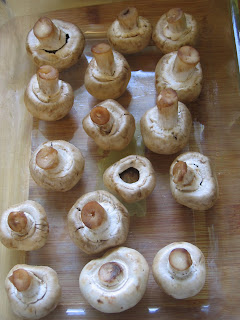Start by making a pie crust. Yes, you can buy a premade one, but once you make your own, you'll realize that there's no point in employing pillsbury for this particular task. I have no pictures of this step, but the recipe I used involves one stick of cold butter cut into cubes, a cup and a quarter of flour (any will do, but I used whole wheat pastry flour), a pinch of salt (unless you're using salted butter), and a few tablespoons of ice-cold water. Keep in mind that if you use whole wheat, you'll probably need a bit more water. Throw the butter, the salt and the flour into your food processor and pulse until it looks like pea-sized clumps. If you have a fancy food processor that comes with a plastic S-blade, use it. At this point, dribble in a tablespoon of water at a time while pulsing just until the dough forms one ball. Now take it out, flatten it slightly, wrap it in plastic wrap (aka saran crap, at least in my family) and refrigerate it for at least an hour.
While your dough is chilling, cut up some veggies into bite-sized pieces and roast them with salt, pepper, and olive oil. I used asparagus and kabocha squash (because I love it so very much). When cooking asparagus, get rid of the tough bottom of the stem by grasping both ends lightly and bending until it breaks. That's the sweet spot. Also keep in mind different cooking times. For instance, squash takes considerably longer than asparagus to roast. Therefore I put it in first and added the asparagus later. Sorry for the lack of pictures of this step too. I was kind of wingin' it.
At this point, turn your oven down to 350F.
Now cut some cheese into 1/2-inch cubes. I used a combination of cave-aged Swiss gruyere and what is essentially monterey jack marbled with jamaican jerk spices (Beecher's No Woman from Seattle if you care) but, again, whatever you're tired of looking at in your fridge will work.

Oh look at that, there are my roasted veggies. Notice how I kept the asparagus tops separate. Stay tuned.

Remove your dough from the fridge and unwrap it. Place it on a lightly floured surface (I really really like a silpat to keep the dough from sticking) and roll it out gently to about a quarter-inch thickness. By the way, look how nice this picture turned out with the bokeh and everything! And that's just with a point-and-shoot camera. Too bad the dough is cracked though. That's how I figured out it needs a bit more moisture with whole wheat. See, I'm learning too!

Anyway, this is how your rolled-out dough will look. Stop periodically to make sure it's not sticking too badly. The crust should be big enough to overlap over the edges of a pie tin.

Or pie-rex if you will.

Gently lift the dough into the dish and cut off the really overhanging bits. Use these scraps to patch up any cracks or spots where there wasn't enough dough.

Artfully pinch the edges. It doesn't have to look too nice, but it wouldn't hurt either.

Throw your veggies (except the asparagus tops) into your pie crust and arrange so they're pretty level. Beat 6 eggs with salt, pepper, and a splash of milk and pour them over the veggies.

Uh, make that 8 eggs.

There, much better!

Now arrange the asparagus tops on top in a nice pattern and bake until the middle is set. It took me about 55 minutes, but check starting at about 35. You don't want the quiche to burn. If the top (or crust) looks like it's turning dark but the middle is still jiggly, cover it loosely with foil for the rest of the cooking process.

Serve hot, cold, or room-temp. It's all good! (This is room temperature).











































